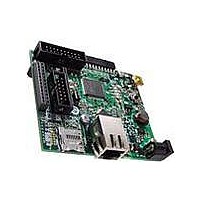STEVAL-PCC012V1 STMicroelectronics, STEVAL-PCC012V1 Datasheet - Page 16

STEVAL-PCC012V1
Manufacturer Part Number
STEVAL-PCC012V1
Description
BOARD DEM CONN GATEWAY STM32F107
Manufacturer
STMicroelectronics
Series
STM32r
Type
Other Power Managementr
Datasheets
1.STM32F105V8T6.pdf
(101 pages)
2.STEVAL-PCC012V1.pdf
(10 pages)
3.EVALST7590-1.pdf
(43 pages)
Specifications of STEVAL-PCC012V1
Main Purpose
Interface, Connectivity
Embedded
Yes, MCU, 32-Bit
Utilized Ic / Part
STM32F107
Primary Attributes
Ethernet and 4 Digital/Analog Connectors
Secondary Attributes
On-Board LEDs and Joystick
Interface Type
Ethernet, USB, I2C, SPI, UART
Operating Supply Voltage
3.3 V
Product
Power Management Development Tools
Lead Free Status / RoHS Status
Lead free / RoHS Compliant
For Use With/related Products
STM32F107xx
Other names
497-10757
Available stocks
Company
Part Number
Manufacturer
Quantity
Price
Company:
Part Number:
STEVAL-PCC012V1
Manufacturer:
STMicroelectronics
Quantity:
1
Description
Note:
2.3.13
2.3.14
16/101
●
The RTC, the IWDG, and the corresponding clock sources are not stopped by entering Stop
or Standby mode.
DMA
The flexible 12-channel general-purpose DMAs (7 channels for DMA1 and 5 channels for
DMA2) are able to manage memory-to-memory, peripheral-to-memory and memory-to-
peripheral transfers. The two DMA controllers support circular buffer management,
removing the need for user code intervention when the controller reaches the end of the
buffer.
Each channel is connected to dedicated hardware DMA requests, with support for software
trigger on each channel. Configuration is made by software and transfer sizes between
source and destination are independent.
The DMA can be used with the main peripherals: SPI, I
and advanced control timers TIMx, DAC, I
In the STM32F107xx, there is a DMA controller dedicated for use with the Ethernet (see
Section 2.3.20: Ethernet MAC interface with dedicated DMA and IEEE 1588 support
more information).
RTC (real-time clock) and backup registers
The RTC and the backup registers are supplied through a switch that takes power either on
V
registers used to store 84 bytes of user application data when V
They are not reset by a system or power reset, and they are not reset when the device
wakes up from the Standby mode.
The real-time clock provides a set of continuously running counters which can be used with
suitable software to provide a clock calendar function, and provides an alarm interrupt and a
periodic interrupt. It is clocked by a 32.768 kHz external crystal, resonator or oscillator, the
internal low power RC oscillator or the high-speed external clock divided by 128. The
internal low-speed RC has a typical frequency of 40 kHz. The RTC can be calibrated using
an external 512 Hz output to compensate for any natural quartz deviation. The RTC features
a 32-bit programmable counter for long term measurement using the Compare register to
generate an alarm. A 20-bit prescaler is used for the time base clock and is by default
configured to generate a time base of 1 second from a clock at 32.768 kHz.
For more information, please refer to AN2604: “STM32F101xx and STM32F103xx RTC
calibration”, available from www.st.com.
DD
supply when present or through the V
Standby mode
The Standby mode is used to achieve the lowest power consumption. The internal
voltage regulator is switched off so that the entire 1.8 V domain is powered off. The
PLL, the HSI RC and the HSE crystal oscillators are also switched off. After entering
Standby mode, SRAM and register contents are lost except for registers in the Backup
domain and Standby circuitry.
The device exits Standby mode when an external reset (NRST pin), an IWDG reset, a
rising edge on the WKUP pin, or an RTC alarm occurs.
Doc ID 15274 Rev 5
2
BAT
S and ADC.
pin. The backup registers are forty-two 16-bit
2
C, USART, general-purpose, basic
STM32F105xx, STM32F107xx
DD
power is not present.
for



















